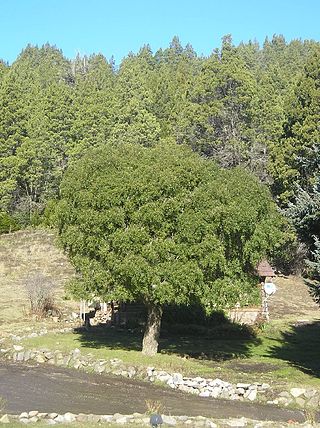
Xylosma is a genus of flowering plants in the family Salicaceae. It contains around 100 species of evergreen shrubs and trees commonly known as brushhollies, xylosmas, or, more ambiguously, "logwoods". The generic name is derived from the Greek words ξύλον (xylon), meaning "wood, tree", and ὀσμή (osmé), meaning "smell", referring to the fragrant wood of some of the species. The Takhtajan system places it in the family Flacourtiaceae, which is considered defunct by the Angiosperm Phylogeny Group.

Plumeria, also known as frangipani, is a genus of flowering plants in the subfamily Rauvolfioideae, of the family Apocynaceae. Most species are deciduous shrubs or small trees. The species are native to the Neotropical realm, but are often grown as cosmopolitan ornamentals in tropical regions, especially in Hawaii, as well as hot desert climates in the Arabian Peninsula with proper irrigation.

Stenandrium is a genus of flowering plants in the family Acanthaceae native to the Americas, with 50 species of perennial herbs ranging from the southern United States to northern Argentina and central Chile.

Casasia is a genus of flowering plants in the family Rubiaceae. These shrubs or small trees occur on the Caribbean islands and in one case in Florida. Some of the ten accepted species were formerly placed elsewhere, e.g. in the related genip-tree genus (Genipa), in Gardenia or in Randia.

Ginoria is a genus of plants in the family Lythraceae. It contains 13 species which are native to southern Mexico and the Caribbean.
Henriettea is a genus of flowering plants in the family Melastomataceae, with some 399 species accepted. It is distributed in the Americas. Some species in the genus are known commonly as camasey., though the common name camasey may also refer to plants of genus Miconia.

Maytenus is a genus of flowering plants in the family Celastraceae. Members of the genus are distributed throughout Central and South America, Southeast Asia, Micronesia, and Australasia, the Indian Ocean and Africa. They grow in a very wide variety of climates, from tropical to subpolar. The traditional circumscription of Maytenus was paraphyletic, so many species have been transferred to Denhamia and Gymnosporia.

Wallenia is a genus of flowering plants in the family Primulaceae endemic to the West Indies.

Rondeletia is a genus of flowering plants in the family Rubiaceae. It is endemic to the Neotropics. There are around 160 species.

Galactia is a genus of plants in the legume family (Fabaceae). It belongs to the subfamily Faboideae and tribe Diocleae They do not have an unambiguous common name, being commonly called milk peas, beach peas or wild peas. They are perennial herbs or subshrubs with prostrate, climbing, or erect forms.

Harpalyce is a genus of flowering plants in the family Fabaceae. It belongs to the subfamily Faboideae. It includes 35 species of shrubs and small trees native to the tropical Americas. Their distribution is disjunct, ranging from Mexico to Nicaragua, Cuba, and northern to southeastern Brazil and Bolivia. Typical habitats include seasonally-dry tropical forest, warm-temperate humid forest, woodland, bushland and thicket, shrubland, and grassland. Most species are evergreen and flower during the dry season.

Chaptalia is a genus of flowering plants in the family Asteraceae.

Guettardeae is a tribe of flowering plants in the family Rubiaceae and contains about 748 species in 14 genera. Its representatives are widespread geographically and are found in the tropics and subtropics.
Solenandra is a genus of flowering plant in the family Rubiaceae, native from Mexico to Central America and the Caribbean. The genus was established by Joseph Dalton Hooker in 1873.

Mitracarpus is a plant genus in the coffee family Rubiaceae. Girdlepod is a common name for some species in this genus.

Varronia is a genus of flowering plants in the family Boraginaceae, found throughout Latin America, the Caribbean, and in the US states of Texas and Florida. They were resurrected from Cordia in 2007.












